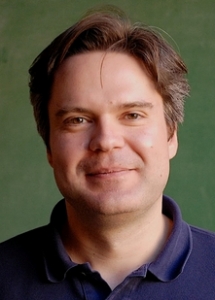Dec 13 2013
Clemens Heitzinger, assistant professor of applied mathematics in the School of Mathematical and Statistical Sciences, has recently been awarded the prestigious START Prize by the Austrian Science Fund FWF.
 Clemens Heitzinger, assistant professor of applied mathematics in the School of Mathematical and Statistical Sciences. Photo by: Rhonda Olson
Clemens Heitzinger, assistant professor of applied mathematics in the School of Mathematical and Statistical Sciences. Photo by: Rhonda Olson
The START program of the Austrian Science Fund FWF is the most lucrative and prestigious funding program for young researchers in Austria. The START Prize is an international competition among all areas of science. It supports outstanding young scientists with long-term and extensive financial security to start or build up their own independent research group and keep it running. Heitzinger’s START award provides 1.2 million Euro, or over $1.6 million, over six years.
Real impact for quality of life
Heitzinger’s research project, “Partial-Differential-Equations Models for Nanotechnology,” aims to develop mathematical models and simulation tools for new applications in nanotechnology, which is the study of how to manipulate matter at the molecular and atomic levels.
The applications are at the forefront of research in health care and quality of life. “Nanowire biosensors are interesting because you can detect small quantities, for example, of tumor markers. So one idea is that you draw only a tiny amount of blood and see if you are sick or not,” explains Heitzinger.
“Another application is related to toxic gases. For example, carbon monoxide is an extremely toxic gas, so if your heating system fails there is a good chance you may die at home and you’ll have never noticed the gas. Nanowire sensors enable the detection of tiny amounts of bio and gas molecules, such as toxic gases. Companies like Samsung have the idea to put nanowire gas sensors into mobile phones.
“Nanopores are expected to be a basic technology for next-generation DNA sequencing. They can also detect single molecules, which has many potential applications.”
Heitzinger’s modeling and simulation work is also relevant for metamaterials, which are materials with an engineered fine structure. There is much commercial interest in optical metamaterials for things such as smartphone cameras.
Better design and new technologies
These applications lead to new model equations and systems, and to more complex mathematical problems. “Our goal is to provide quantitative understanding of these current and relevant applications,” Heitzinger explains. “Quantitative understanding allows better design and supports the development of new technologies.”
He aims to use deterministic and stochastic differential equations and systems of them to model new devices, to prove mathematical properties of these equations and systems, and to develop efficient numerical algorithms for realistic simulations.
Mathematical modeling and computation are used to help theoretically understand the behavior of nanomaterials. Computer simulations of the behavior of these materials can also help reduce the costs of building numerous prototypes.
The field of stochastic differential equations is the basic tool used in this modeling process. A differential equation is an equation involving the derivatives of the unknown function that describes the behavior of the material, such as the electrical current through the material. The term stochastic refers to the fact that many of the terms in the equation represent quantities that are subject to random effects.
The beauty of mathematics
“We just hired Clemens Heitzinger as an assistant professor of applied mathematics and I am very pleased that he was awarded the Start Prize for 2013-14,” said Al Boggess, director of the School of Mathematical and Statistical Sciences in the College of Liberal Arts and Sciences. “This is a great honor since only nine recipients were selected this year for this highly competitive award. Heitzinger's research program epitomizes one of the fundamental values that mathematics brings to society: mathematical modeling allows researchers to study the behavior of complex systems in science and engineering by using computer simulation and without building expensive prototypes. It is heartening to see that this fundamental value of mathematics, and Heitzinger's research program in particular, is being rewarded by the Austrian Minister of Science in the granting of this Start Prize.”
“The beauty of mathematics is that our mathematical models and results are very abstract and, hence, they are applicable to various different applications,” Heitzinger says of his work. “Our mathematical results make it possible to calculate what could not be calculated before.”
Quantitative understanding
“Sometimes in experiments you don’t really know what’s going on, why something is happening. There may be different effects, you don’t know which one you are measuring at this point in time. So the simulations should give you a quantitative understanding of what’s going on – which effect is actually the important one, which is the one I’m measuring right now.”
Heitzinger’s mathematical techniques will enable researchers to build highly effective simulations that are more accurate and less expensive than building traditional prototypes. “Once you have confirmed your simulations match to reality, then you can optimize quite easily. If you were to build a new device each time, those are really expensive and take lots of effort to build them. But if I have the simulation, I can change the device parameters easily so you can understand what is going on and you can optimize it.
“At the end of the day it should be really useful work, in the sense that once you can simulate those devices and structures, it provides quantitative understanding so you understand better what’s going on.”
International collaboration
In the START project, Heitzinger will collaborate with international partners here at Arizona State, the University of Cambridge, Columbia University, Yale University, Cavendish Laboratory at the University of Cambridge, Imperial College London and the Materials Center Leoben in Austria.
Rhonda Olson, [email protected]
480-727-2468
School of Mathematical and Statistical Sciences